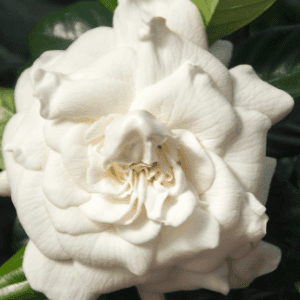6 Steps to”Right Plant -Right Place“ With Varieties
Success growing Gardenias is not difficult. The Gardenia is a plant that perfectly makes the case for the idea of “right plant-right place” that we have been taught for so long! We do need to plant the gardenias where they grow best. The Gardenia has simple but specific requirements and if we can meet them we will succeed.
Here are the key requirements of the gardenia. Missing these steps are the errors most likely to cause disappointment.
- Plant in the sun; in late summer a little afternoon shade can be a boon but the gardenia wants sun. In shade, the plant develops long, spindly stems, few leaves, and buds that do not mature.
- Plant with enough space for air circulation. Follow the spacing instructions on your new planter. This prevents pest infestation by keeping the plant healthy and allows the wonderful scent to prevail. Some of our gardenias sit next to a covered porch. We sit out a lot more often when gardenias are in bloom.
- Provide regular water and fertilize two or three times per year depending on your climate. Here in Florida, gardenias require 3 feedings.
- Prune, but only after the plant has finished blooming and always before October to preserve next year’s buds.
- Amend your soil with compost. Gardenias do best in rich soil which drains well.
- Pests such as mealybugs, scales, aphids, and whiteflies are the most significant cause of Gardenia’s failure. Practice good husbandry, including sterilized cutting tools. Be prepared to treat the plant with insecticidal soaps or horticultural oils in cases of infestation.
Gardenias are a great source of pleasure at home, but do not expect to avoid any work at all! We will do a little work for our pleasure. They are not “low maintenance” plants. We grow several and believe the fairly modest effort is well worth doing for the gratification they provide. It is a choice to make before you start.

The Gardenia scent is memorable, we like to sit out at night and enjoy the perfume. It is so evocative that it becomes a subject of conversation. The creamy blossoms come in the warm weather, and the shiny, leathery foliage is constantly green.
How Did We Get The Gardenia?
The plant is native to China, Taiwan, and Japan, it is a member of the coffee family, (Rubiaceae). Gardenias have a long history of cultivation. Our recorded history offers records and images of them as far back as the Song Dynasty, (that’s 960-1279!) They appear in the images as both the wild single blossoms and cultivated doubles.

We are not the first lovers of the Gardenia. here they are, depicted on a Ming Dynasty plate found today in the British Museum. Western visitors saw these by the 18th century. They couldn’t resist!
Gardenia Attributes
Gardenias are showy, evergreen shrubs, some reach 8′ tall. They are valued for their pale, glowing blossoms, shiny hard green leaves, and of course the spectacular scent. Depending on the variety, the plants bloom between springtime and late fall.
Gardenias come in over 200 species and while the favorite color is the rich, creamy white you can find them in pink, red, pale yellow, and sometimes with purple mottling.
The Gardenia Scent
The smell is sweet but can change throughout the day. It has elements that are spicy and sometimes you may notice a little coconut and peach.
In our garden, we have heavy spring blooms and a reasonable amount throughout summer through fall. The scent is with us during the day and night.
Where Did The Name Come From
Carl Linnaeus and John Ellis an English linen trader and botanist named the plant for Alexander Garden, a Scottish physician who was an active botanist in Charleston SC in the 18th century. Garden was a physician during the time when practicing medicine required knowledge of flora and fauna. Wherever he was located he studied the natural world, even sending plants to Linnaeus.
You may be noticing that in earlier centuries, the combination of physician and botanist was common. At a time when medicines were plant-based, you needed extensive botanical knowledge to practice medicine. Here is a story, referencing Dr. John Hall, an English Physician/Botanist who was also William Shakespeare’s son-in-law. We visited his home and gardens in Stratford Upon Avon. His garden is called Hall’s Croft. Of course, as medical labs go, it was a primitive one but calm and beautiful.
How To Be Successful Growing Gardenias
Where Can I Plant Gardenias?
Gardenias are hardy in USDA plant hardiness zones 8-11. Some new varieties are hardy to zones 7 or 6. Check with your local garden center. In the northern end of the zone plant Gardenias in a sheltered spot where strong winds can not damage them.
How To Plant Gardenias
For success growing Gardenias, dig a hole twice the width of the root ball and a little deeper. Add a little soil to the bottom of the hole. Place the plant in the hole so that the top of the root ball is even with the soil. Water the new plant deeply.
Try to avoid planting the Gardenia close to a concrete foundation as the pH may be too high (alkaline).
Light Conditions
Gardenias prefer full sun to part shade. Sun is preferred unless a very strong afternoon sun can burn the foliage. For example in our zone 10a South Florida borderline tropical garden we love Gardenias. We plant them on the east/south side of the house. The sun is primarily in the morning and they are located near a covered porch on the front and the pool on the back. If you plant Gardenias you will want to sit (or float) near them whenever you can.

Soil for Gardenias
Gardenias prefer well-drained, rich, and acidic soil, amended with plenty of organic matter and fertilizer. pH is important and should be slightly acidic between 5.0 and 6.5.
The pH Scale-How it Works
The pH scale runs from 1-14 with 7 being neutral. The low numbers are acidic. Lemon is acidic. The high numbers are alkaline and a good example is lime.
Water And Fertilizer for Gardenia
Water- Gardenias need at least 1″ of water per week. Do not permit the soil to dry out between waterings. Gardenias are the ultimate “Goldilocks” plants, not too wet, not too dry. Check with your fingers.
Fertilizer- feed monthly with an acid plant fertilizer between April and November. Do not overuse the fertilizer as this will reduce blooms. Do not fertilize in winter.
Maintenance And Pruning
Prune the plants after the blossoms have finished blooming for the season and when the plant enters the dormant period. Do this in late summer and you will be able to shape the plant without endangering the new buds. Prune a stem back to 1″ above a leaf jointure on a stem. Give the bush an even, mounded shape.
Pests and Diseases of Gardenia
Most diseases of Gardenias are caused by fungus. The best defense is to maintain good air circulation and drainage. They include these problems:
Diseases
Root Rot: The foliage appears yellow and this starts with the older leaves and progresses toward the newer ones. If the plant’s location does not drain correctly, dig up the plant, prune any damaged roots and replant in a spot with better drainage.
Powdery Mildew: is caused by poor air circulation which allows humidity to build up around a dense bush or tree canopy. Powdery mildew appears as a fuzzy white coating on the plant. Neem oil, available in garden centers, is an effective control as is thinning the canopy.
Stem Canker: is a rare but severe problem. It appears as dark oval lesions, which tend to come from injury. The affected branches need to be removed and include cutting well into healthy tissue. Disinfect all tools.
Bud Drop: Pests and environmental problems cause this baffling problem in which flowers drop before maturing. Check for tiny insects and sooty mold.
Pests
Aphids: feed on the sap of plants, they can reproduce rapidly and do damage. Look for tiny bodies or sooty mold. You can treat them with a strong spray of water, by removing damaged leaves, or with horticultural oils and soaps.
For more science-based information try this article from Clemson University. It is a good discussion of pests that attack Gardenias. You can print and save it.
Can You Grow Gardenias Indoors
Yes, you can. Yes, an indoor Gardenia will be a real treat indoors next winter. You will work for your success, however. Are you ready? Here is what to do:
- First, pick the spot first, gardenias do not take well to being moved. Your spot needs a sunny window for 6-8 hours. Be prepared to provide rich and well-drained soil.
- The potting soil should contain peat and sand and a small amount of acidic compost.
- If you cannot provide bright indirect light consider a grow light.
- Humidity, you will need to provide, and with dry heat, this can be a challenge. Use a pebble tray, and group your houseplants together this will help.
- If you are having trouble providing sufficient humidity you can consider a bathroom.
- Temperature, warm daytime temperatures are fine. In the nighttime, temperatures need to be cool, ranging from 50°-63.
- Feed with an acid-based fertilizer on a monthly basis.
- Do not repot unless the roots are filling the pot.
- Run a humidifier or mist the plants in the morning.
- The dreaded bud drop should not happen, if it does, recheck all the above.
Gardenia Varieties:
While Gardenias are hardy in zones 8-11, some varieties are hardy in zone 7. In colder environments, they can be used in containers that can come indoors during cold weather.
This table highlights desirable varieties to grow, it includes the hardiness zones, sizes, and forms as well as flower and foliage features.

One of the Double Blossom Varieties
Gardenia Varieties
| VARIETY NAME | SIZE & Hardiness Zone | FLOWER.FOLIAGE FEATURES | BLOOM PERIOD | USE | NOTES |
| Aimee | 4′-6′ Tree 8-11 | Creamy white, large dense flower, dark green foliage-intense scent. | Late spring-early summer | Tree, in-ground, or pots | For Florida |
| August Beauty | 4′-6′ Tree 8-11 | large white blossom, prolific | Mid-spring-summer | hedge, tree | Part/sun-full/sun |
| Belmont | 4-8’T, 3-6’W 7-11 | creamy white | Spring-late summer | shrub-hedge | For Florida Full-part sun |
| Frost Proof | Upright small in container- to 5’in ground. 5-7 | Large white blossom, glossy leaf | Late spring to fall | Hedge | Takes more sun than most varieties |
| Golden Magic | 2×3’T, 2×3’W 7-12 | Butter yellow flower | Spring/summer | Bed, border, container | intense scent |
| Kleim’s | 2-3″versatile dwarf 7-10 | Showy large flower | Late spring-early summer | border, container, hedge | P/S-F/S takes more sun than most (give some protection) |
| Mary Ann | 8-12 | Large Blooms, late-season blooms | Spring-Fall | For Florida | |
| Miami Supreme | to 6′ 7-11 | very large flower | late spring/summer | hedge, border, bed, hedge, screen | For Florida |
| Mystery | 6-8′ 8-11 | Large flower, white fades to yellow | Spring/summer/early fall | hedge, specimen | |
| Radicans | Miniature, prostrate, spreading 8-11 | small, 1″ blossom | Late spring/early summer | groundcover | AM sun/PM shade |
| Veitchii | 4′-3’W 8-11 | Roselike blossom | Spring -fall | border, container | long bloom period |
| Viet Nam | 4’6″x4’6″ 10-11 | Strong scent | 7 months of bloom in Florida | For Florida requires acid soil or acidification | |
| White Gem | white blossom, yellow center, star-like | white blossom, yellow center, star like | spring-fall | border, raised bed, container | short, compact |
Summary,
Check the table for varieties that grow in your planting zone and are naturally within the shape and size that your site requires. Most Gardenias prefer sun in the morning and some afternoon shade. This is particularly true in the heat of summer.
Companion Plantings
Begin to select companion plantings first by growing conditions. The Gardenia requires moist but well-drained, slightly acidic soil, amended with plenty of organic matter. First, select plants that thrive in the same conditions.
Here are some ideas:
Annuals-Impatiens, and Wax Begonias. Use varieties that can accept the same sun conditions as the gardenia. For example, use one of the sunpatiens rather than the traditional shade-loving varieties.
Perennials- Hosta, Lillies, Ferns, also try toad Lillies and Solomon’s seal.
Shrubs-Azaleas, Rhododendrons, Camellias. Boxwood with its tiny leaf is a classic pairing.
Trees- Choose trees with color and texture to contrast with the gardenia. Dogwood, Japanese Maples, and Crape Myrtles are good examples.
Gardenias can be irresistible for their scent and creamy blossoms as well ant the rich leathery foliage. Try them if they fit your garden
‘Its May in the South Florida Garden.’– Gardenias in Bloom.
